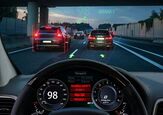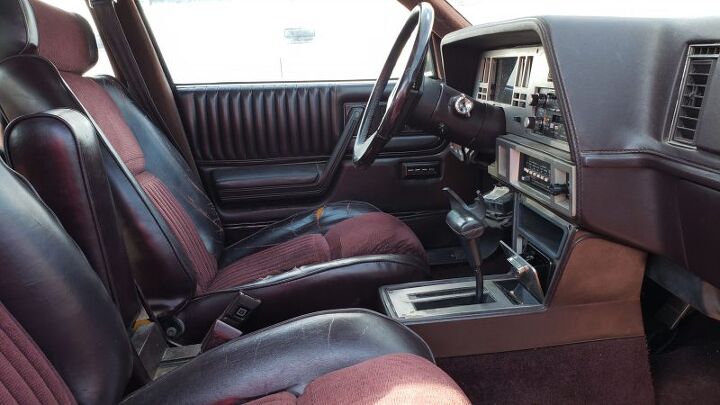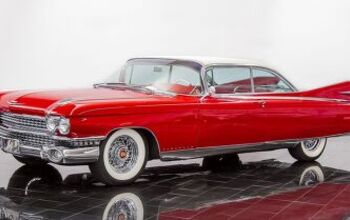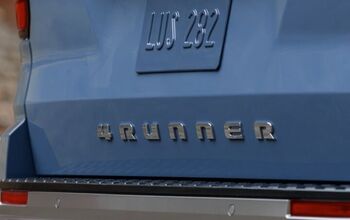Junkyard Find: 1985 Cadillac Cimarron

Way back in 2007, I kicked off the Down On the Street series (which was supposed to be a one-time reference to the title of a Stooges song beloved by me and the late Davey J. Johnson) with the first of what would turn out to be hundreds of interesting street-parked cars: a 1984 Cadillac Cimarron d’Oro. That led to something of a Cimarron obsession, and I’ve spent the past 15 years documenting every semi– intact Cadillac J-Body I find during my junkyard adventures. You’d think they’d all have been crushed by now, but such is not the case; I found this loaded Brown Overload Edition ’85 in a yard near Pikes Peak earlier this year.
The Cimarron was the Cadillac-badged version of the Chevrolet Cavalier (or, if you prefer, the Cadillac-badged version of the Isuzu Aska), and it cost about twice as much as a Cavalier. Sales spanned the 1982 through 1988 model years.
The Cadillac Division had scored a big sales success with a Cadillac-ized Chevy Nova in the late 1970s, and something had to be done about small European luxury sedans stealing Cadillac sales.
Unfortunately for The General, there’s only so much you can do to turn a cheap transportation appliance into a credible swankmobile, and now nearly everyone jeers at the very idea of the Cimarron.
My wife’s Wisconsin family stayed loyal to General Motors products for most of the 20th century, with her parents working their way from Chevrolets on to Buicks and her grandparents climbing Sloan’s Ladder of Success from Oldsmobile all the way up to the pinnacle: Cadillac. Upon retirement in the middle 1980s, it seemed prudent for Grandpa to trade in the Sedan DeVille for a new Cimarron. So, he took the DeVille from Milwaukee down to Francis A. Whibbs‘ dealership in Chicago and picked up the new Caddy… which turned out to be a disappointing lemon that spent more time in the shop than on the street. At least they saved the Cimarron’s keychain, which I now own.
This brown and maroon-ish brown interior appears to be the “Ripple cloth and Sierra Grain leather seating area combination” and was far nicer than anything you could get in the prole-grade Cavalier.
The digital gauge cluster added $238 to the Cimarron’s $12,692 price tag (that’s about $650 on a $34,590 car when reckoned in 2022 dollars). It wasn’t as cool as the digital dash of the Subaru XT, but still futuristic stuff for 1985.
Unlike most other J-Bodies for 1985, the Cimarron came with an AM/FM radio as standard equipment (or you could get a $151 credit for deleting the radio). This “Symphony Sound” cassette deck with AM stereo and a five-band equalizer added 299 bucks (about $815 today). If you wanted this radio with a built-in CB ( so you could give a big 10-4 to the trucker man), it cost $895 ($2,440 now). In 1985, I was paying $1,296 for that year’s tuition at the University of California (plus $50/month for rent at the on-campus trailer park, where students could perform engine swaps in their front yards), so the idea of a CB radio for nearly as many frogskins as a quarter’s tuition would have seemed shocking to me at the time.
The base engine in the ’85 Cimarron was the same 2.0-liter four-banger found in the Cavalier, but with 88 horses instead of the Chevy’s 85. This car has the optional 2.8-liter V6, rated at 125 horsepower and adding $560 to the car’s price tag. I’d have shot photos of the engine, but the hood latch mechanism was broken and I didn’t feel like messing with it in order to see an engine I’ve photographed many times before.
Believe it or not, the base transmission in the 1985 Cimarron was an old-timey four-on-the-floor manual, though nearly all Cimarron buyers spent the extra $350 ($955 now) for the automatic. I’ve managed to find a junkyard Cimarron with the rare V6/4-speed combination, amazingly.
This car also has the optional 14″ alloy wheels, which cost just 40 additional bucks.
This DALE sticker probably dates back to the car’s early days on the road.
The keys were still in it when it showed up to its final parking spot.
I picked up a 2009 Hyundai Accent radio for a car-parts boombox project that day (late-2000s Hyundais are among the few junkyard cars that offer factory radios that have AUX jacks but no CAN Bus requirements), and you can see it sitting next to my trusty junkyard toolbox in this photo.
The Cimarron was done after 1988, though its Cavalier/Sunfire platform-mates carried on well into our current century.
[Images courtesy of the author]

Murilee Martin is the pen name of Phil Greden, a writer who has lived in Minnesota, California, Georgia and (now) Colorado. He has toiled at copywriting, technical writing, junkmail writing, fiction writing and now automotive writing. He has owned many terrible vehicles and some good ones. He spends a great deal of time in self-service junkyards. These days, he writes for publications including Autoweek, Autoblog, Hagerty, The Truth About Cars and Capital One.
More by Murilee Martin
Latest Car Reviews
Read moreLatest Product Reviews
Read moreRecent Comments
- MaintenanceCosts Most of the article after the blockquote is Posky laboring mightily to somehow blame this clearly anticompetitive and oligopolistic conduct on the big bad government.I look forward to some of the usual commenters explaining to us that, actually, the oil industry is a cuddly teddy bear and the real villain is people trying to sell us cars that don't use oil.
- Bd2 A modest price bump for one of the better if not the best vehicle in it's class. And it's a very good deal still considering the Front wheel drive competition over at Lexus to name one. These Genesis vehicles are more like BMWs of the 90s but with better styling.
- Dave M. What???? Big business taking advantage of us? I thought it was all Biden's fault!?!
- OA5599 Now if we could only get Toyota to change BZ4X...
- FreedMike You mean the petroleum market is manipulated and doesn't respond to normal supply/demand? No way. Can't be. This, folks, is why electrification is important - the only reason why the petroleum industry gets away with this is because they were the only game in town for over a century. That has GOT to change or we'll keep getting ripped off.















































Comments
Join the conversation
Love these things, they reek of the 80s. Iconic, really. As a 14 y/o with a C&D subscription I already knew what they were even if the owners didn't. I got to ride in an identical brown/maroon example in Monett , MO. V6 manual. Owner was a family friend was a family doc, and it I suspect it was more of a business decision to support the local GM multistore than drive 1-2 hrs one way to the import store in Springfield or STL for every malady. Being immigrants, every gesture meant something to ingratiate themselves with the locals, even if it meant rolling in one of these. Heck their son drove a Chevy 1500 w/t.
I forgot about the Versailles. It's not really forgivable, but the Ford equivalent would've been a Lincoln pimped out Escort. I'm sure the Versailles came with a basic V8 though and could look the part. It's no worse than the 5th Ave/Fury/Dip, especially today as clean 5th Aves are still around and Fury/Dips long gone and forgotten.